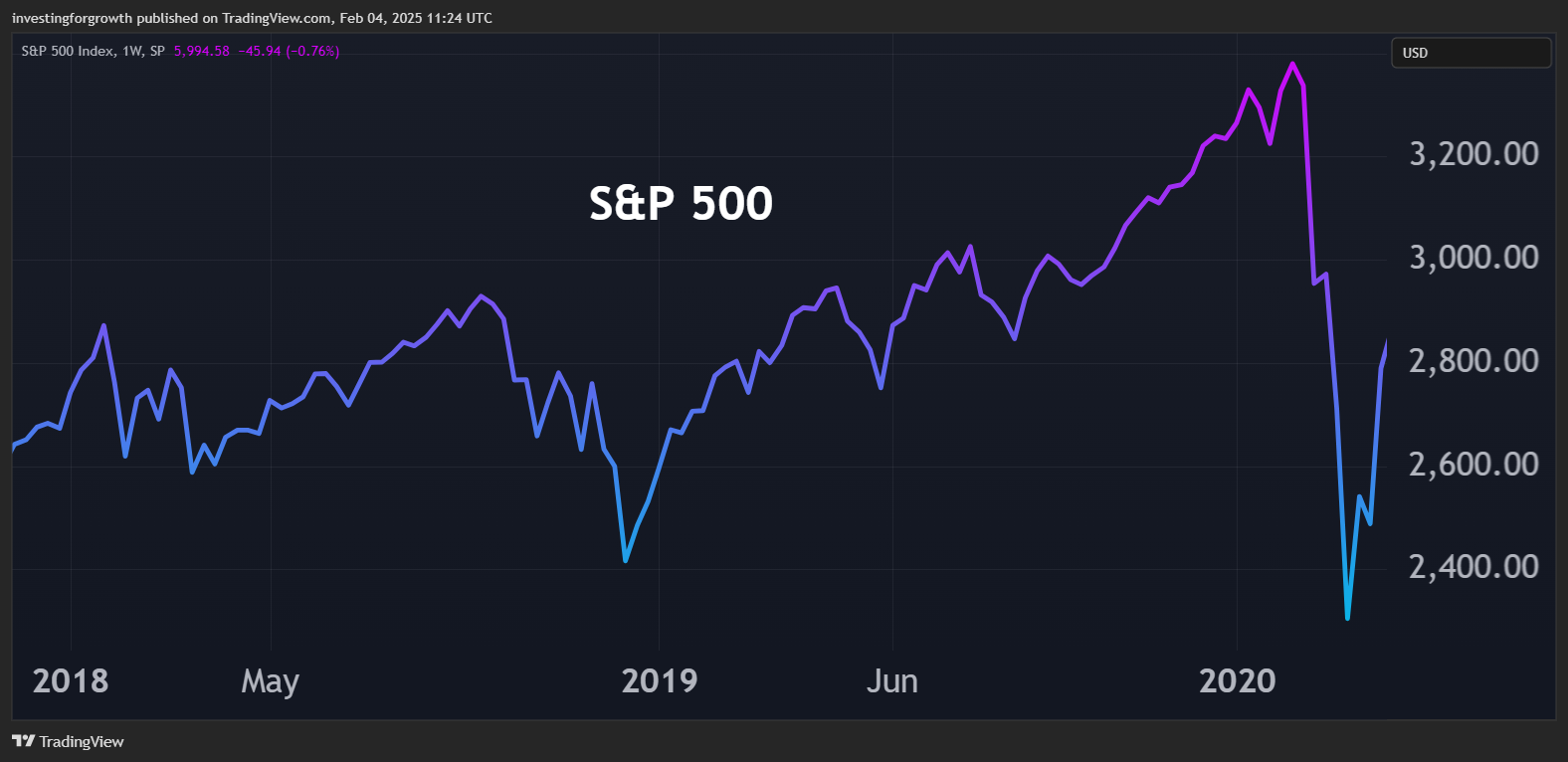Stockwatch: has the stock market correctly priced in Trump tariffs?
While we all wait to see if President Trump’s tariff negotiations are successful or not, analyst Edmond Jackson assesses possible outcomes at what is a tricky time for investors.
4th February 2025 11:36
by Edmond Jackson from interactive investor

So, a North Atlantic trade war has been averted. Sceptics might say “for now” but if Mexico and Canada follow through on US border security, then it puts the Trump administration in a difficult position in months’ time. If it abandons tariffs on these two countries, then it shows the policy as simply a bullying tactic that can be discounted in future.
Yet China could still be suffering 10% extra tariffs and tit-for-tat – potentially the most damaging aspect of all this - has already been unleashed by way of China responding with circa 15% tariffs on US energy items and selective vehicles. At least this is being done intelligently, China having modelled for another Trump scenario, allowing a week for negotiation.
- Invest with ii: What is a Managed ISA? | Open a Managed ISA | Transfer an ISA
It seems hard for Trump to row back on a key pitch of his election campaign - that tariffs are key to unlock prosperity by repatriating manufacturing and lowering personal and corporation tax. Never mind how many years it would take to re-work production chains and bring new factories into operation; that tariffs are effectively a sales tax on consumers also inputs for businesses.
He also pledged to tackle how exports to the US constitute 20% of Canadian GDP and 30% of Mexico’s versus US exports to Canada and Mexico combined at just 3% of US GDP.
You could envisage a situation where 25% threatened tariffs get downgraded to 10% if countries co-operate with Trump’s demands, but how satisfactory would that be as defacto for trade and international relations? Uncertainties would still compromise business investment.
Yesterday, Goldman Sachs’ head of equities strategy pitched in the media, how rates of US companies’ reinvestment are far superior globally (say to the high dividends and buybacks made by those listed in London), which is why US shares remain top priority for international investors.
The likes of Goldman and other top US businesses still need to justify their support for Trump given his measures are effectively anti-business.
Are stock markets taking a justifiably measured, or complacent view?
Even the initial circa 2% drop in global indices first thing Monday, had mitigated to around 1% by the close, the S&P 500 off 0.75% which is just standard daily volatility. This morning, the FTSE 100 is 0.5% easier. As yet this is well within the scope of regular volatility.
Technical analysis of moving averages shows US stock market momentum is well-intact, with no real signs of trends breaking down except on a one-month view. The history of major market breaks on the downside - 1929, 1974, 2000, 2008 – shows they happen after an inflection point and some months of deterioration in moving averages. You could say “September 2011”, but that catastrophe was a bolt from the blue, and the March 2020 Covid lockdowns were also surprising, quite unlike Trump’s tariffs that have been in focus for many months.
Yet with stock markets trading near all-time highs, it invites the question as to what is fair pricing if Trump does follow through with material tariffs.
- 16 UK stocks least likely to be impacted by Trump tariffs
- eyeQ: big tech stock discount triggers bullish signal
- 10 funds to generate a £10,000 income in 2025
Recalling his first presidential term, in January 2018 Trump introduced targeted measures of 30-50% on solar panels and washing machines, proceeding to steel at 25% and aluminium at 10%. This involved most countries and covered an estimated 4% of US imports. It angered trading partners and China and India retaliated proportionately. A May 2019 study claimed the tariffs equated to one of the largest US tax increases, hurting incomes and GDP.
Yet the 2018 chart for the S&P 500 was a bull market from January to end-September, then a 13% fall to early 2019 which set the base for a 17% consistent strong run until Covid impacted in March 2020.

Source: TradingView. Past performance is not a guide to future performance.
But mind how the situation seven years ago involved very low interest rates, which rose to tackle supply inflation post-Covid; and currently (as I explain below) it is sensitive as to when rates can fall again. No way are we going back to the ultra-cheap money that helped boost asset prices globally.
News reports can make this all sound pugilistic, reminiscent of “beggar thy neighbour” in the 1930s, but as yet it is allowing scope for negotiation rather than running out of control. The Australian and New Zealand dollar both weakening today does however show the foreign exchange market is wary about how China’s actions could hurt other Pacific economies.
The Petersen Institute of International Economics – pro free trade – had estimated the 25% tariffs would shrink Canadian and Mexican GDP by 1-2% over the next few years.
A real risk to interest rate cuts
My chief concern is any extent of tariff wars disrupting a delicate balance between inflation and interest rates - which is a crux issue for stock market confidence.
While hard to predict the quantum, tariffs are inherently inflationary just when many countries yearn for lower interest rates. Only last week, the US Federal Reserve kept rates on hold at 4.25-4.5% at its latest meeting, with inflation stubborn around 3% versus its 2% target. In the UK, speculation has increased about an interest rate cut this month leading to several more this year, which helped buoy many UK shares in the second half of January, some small caps re-rating over 20% after previous falls.
Yet this scenario is put in doubt if tariff tensions persist. The Bank of England may cut this month then sit on its hands. I question if UK inflation data will improve given higher utility and council tax bills on the way, rising food inflation and higher prices as firms pass on higher employment tax charges.
Tariffs may not be the ultimate villain but are coming at a time potentially to spoil hopes – at least for interest rate-sensitive shares.
Trump says tariffs on EU will “definitely happen”
While we are seeing intelligent actions by way of delay to allow negotiations, if Trump means what he says, then world trade is moving to higher tariffs this year – given there will be retaliation.
Ironically, and despite likely harm to the US economy, markets still default to a ‘buy the dollar amid uncertainty’ approach. Admittedly, a higher dollar would help Americans mitigate the effect of paying tariffs on imports and further empower US businesses for takeovers abroad. We are likely to see more onshoring of production and distribution in the US, such as the timely partnership between Fevertree Drinks (LSE:FEVR) and Molson Coors Brewing Company TAP five days ago.
- Stockwatch: should you buy the drop in Nvidia?
- ii view: Apple’s holiday quarter breaks records
- The most attractive growth stocks now
Yet I would be surprised to see this latest Republican Party dalliance with trade tariffs – it has engaged on and off since the mid-19th century – succeed in anyone’s interest beyond America indulging the exercise of power.
At least the US economy is in a stronger position now, rather than when the June 1930 Smoot-Hawley Tariff Act added 20% to already high US import duties on foreign agricultural imports – with retaliatory measures contributing to a 66% decline in global trade from 1929 to 1934.
Yet with the US budget deficit well over 6% of GDP and the public debt service costing $308 billion a year (as of last December) to service, or 17% of total federal spending this year, American economic vigour is not guaranteed.
It is a tricky time for investors. In weeks and months ahead, be sure to look up timely charts of moving averages, lest signs of breaking down manifest.
Edmond Jackson is a freelance contributor and not a direct employee of interactive investor.
These articles are provided for information purposes only. Occasionally, an opinion about whether to buy or sell a specific investment may be provided by third parties. The content is not intended to be a personal recommendation to buy or sell any financial instrument or product, or to adopt any investment strategy as it is not provided based on an assessment of your investing knowledge and experience, your financial situation or your investment objectives. The value of your investments, and the income derived from them, may go down as well as up. You may not get back all the money that you invest. The investments referred to in this article may not be suitable for all investors, and if in doubt, an investor should seek advice from a qualified investment adviser.
Full performance can be found on the company or index summary page on the interactive investor website. Simply click on the company's or index name highlighted in the article.
Disclosure
We use a combination of fundamental and technical analysis in forming our view as to the valuation and prospects of an investment. Where relevant we have set out those particular matters we think are important in the above article, but further detail can be found here.
Please note that our article on this investment should not be considered to be a regular publication.
Details of all recommendations issued by ii during the previous 12-month period can be found here.
ii adheres to a strict code of conduct. Contributors may hold shares or have other interests in companies included in these portfolios, which could create a conflict of interests. Contributors intending to write about any financial instruments in which they have an interest are required to disclose such interest to ii and in the article itself. ii will at all times consider whether such interest impairs the objectivity of the recommendation.
In addition, individuals involved in the production of investment articles are subject to a personal account dealing restriction, which prevents them from placing a transaction in the specified instrument(s) for a period before and for five working days after such publication. This is to avoid personal interests conflicting with the interests of the recipients of those investment articles.